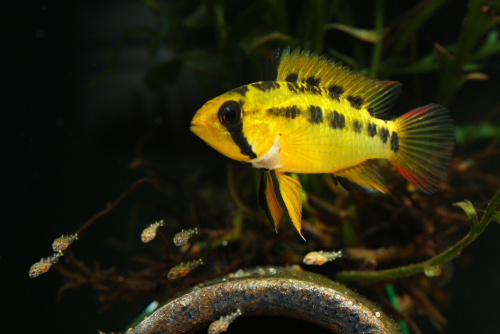If you’ve recently decided on an Apistogramma – also known as a Dwarf Cichlid – for your aquarium, you might be wondering if it’s a good addition to an established community. Or, if you have Dwarf Cichlids and you want to diversify, you might wonder – what are ideal tank mates for Apistogramma?
The best tank mates for Apistogramma are fish that are roughly the same size, with similar environmental requirements. These should also be fish that are relatively peaceful, and prefer upper levels of the tank.
Here we’ll look at some Top 12 options for Apistogramma tank mates.
Contents
Apistogramma Tank Mates – Basics You Need To Know:
Before you start looking for the ideal company for your Apistogramma, it helps to know what you need for your Apistogramma to be at its healthiest and happiest.
Temperament
There are several different types of Apistogramma, or Dwarf Cichlids, and their temperaments can vary as well. However, whatever specific species of Apistogramma you choose, they’re likely to have a temperament along these lines:
– Lively and active: They’re even somewhat playful
– Semi-aggressive: They aren’t as sharp tempered as Jack Dempseys, but they won’t be pushed around.
– Territorial: Apistogrammas tend to set their territory and guard it fiercely
Size
Apistogramma earn their name as Dwarf Cichlids.They’re small fish, and some types are less than an inch long when grown.
No matter what species you choose, however, you’ll rarely encounter an Apistogramma that gets larger than 3 inches.
Competition
Apistogramma tend to be omnivores with a preference for protein rather than plant food.
They’re also bottom-dwellers, so ideal tank mates will prefer the middle and top layers of the tank.
Best Tank Setup
For an optimum environment for your Apistogramma, you’ll want the following parameters:
– 20 to 30 gallons in size.
– Water temperature between 72 and 86 degrees Fahrenheit
– Ph Level 6.0 to 7.0
Sandy substrate and a large number of aquatic plants are both things your Apistogramma will appreciate.
For the best results, stick with tropical plants that imitate their natural environment.
Top 12 Apistogramma Tank Mates:
Here’s the top 12 for Best Apistogramma Tank Mates:
- Neon Tetras
- Rasboras
- Pygmy Corydora
- Bristlenose Pleco
- Pencilfish
- Otocinclus Catfish
- Cardinal Tetra
- Ram Cichlid
- Dwarf Gourami
- Black Skirt Tetra
- Dwarf Rainbowfish
- Kuhli Loach
So…what about these fish makes them the best options for sharing space with an Apistogramma?
You might also like:
- Kribensis Tank Mates
- Electric Blue Jack Dempsey Tank Mates
- Fahaka Puffer Tank Mates
- Bumblebee Goby Tank Mates
1. Neon Tetras
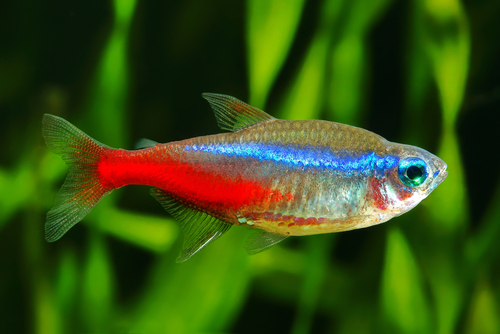
- Scientific Name: Parachierodon innesi
- Adult Size: Usually 1 to 2.5 inches
- Preferred Tank Mates: Apistogramma (any kind), Rasboras, Dwarf Gourami
- Preferred Water Temperature: Between 70 and 81 degrees Fahrenheit
- Minimum Tank Size: 10 to 20 gallons
- Difficulty of Care: Moderate
- Origin: South America, specifically the Amazon Basin
Neon tetras are at the top of the list because they love being in a diverse community, and they thrive in many of the same conditions the Apistogramma does.
They’re adaptable and social fish with brightly colored scales that make a popular and friendly addition to any tank.
Pros/Cons:
| Easily adaptable | Needs a school of at least 5 to be comfortable |
| Easy to feed – omnivores | May be competition for food |
| Energetic and brightly colored |
2. Rasboras
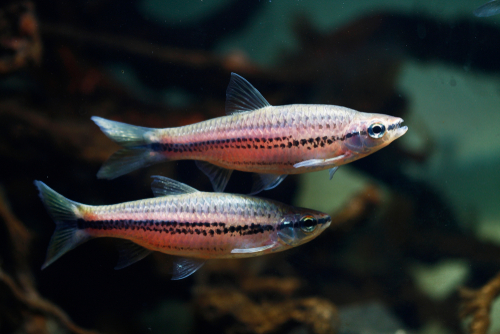
- Scientific Name: Rasbora (Full name depends on which specific breed you choose)
- Adult Size: 4 inches or less
- Preferred Tank Mates: Apistogrammas,Neon Tetras, Dwarf Gouramis, Kuhli Loach
- Preferred Water Temperature: 75 to 80 degrees Fahrenheit
- Minimum Tank Size: 20 gallons or more
- Difficulty of Care: Easy
- Origin: Southeast Asia and China
These fish are small, peaceful and colorful fish that enjoy being social. Because they prefer the middle of the tank, they’re not going to get into territory disputes with your Apistogrammas.
Pros/Cons:
| Friendly and easily adaptable | Requires a school of 6 or more to be happy |
| Easy to feed – omnivores | May be competition for food |
| Don’t need much space | May be targeted or eaten by larger fish |
3. Pygmy Corydora
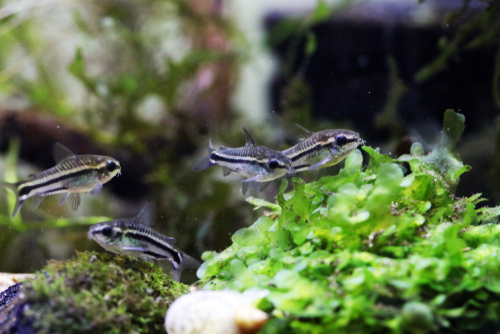
- Scientific Name: Corydoras pygmaeus
- Adult Size: About 1 inch
- Preferred Tank Mates: Apistogrammas, Neon Tetras, Kuhli Loach, Dwarf Gourami
- Preferred Water Temperature: 72 to 79 degrees Fahrenheit
- Minimum Tank Size: 10 gallons
- Difficulty of Care: Easy
- Origin: South America
These little fish are also primarily bottom dwelling fish, but they’re peaceful and enjoy the company of other species. As long as there’s enough room to swim around, they’ll be the perfect ‘live and let live’ tank mates.
Pros/Cons:
| Small and take up no space | May become a snack |
| Playful and friendly, inhabiting all areas of the tank | May wind up invading Apistogrammas territory |
| Easy to feed – omnivore | Can wind up competing with Apistogrammas for food |
4. Bristlenose Pleco

- Scientific Name: Ancistro Cirrhosus
- Adult Size: Up to 5 inches
- Preferred Tank Mates: Apistogramma, Neon Tetras, Guppies, Platies
- Preferred Water Temperature: 60 to 80 degrees Fahrenheit
- Minimum Tank Size: 25 gallons (more in community tanks)
- Difficulty of Care: Beginner
- Origin: Central and South America
Bristlenose Plecos are considered some of the ‘Great Tank Cleaners’, and they’re fun to watch. They’re also extremely peaceful, and even if an Apistogramma gets unfriendly, they have armor to protect themselves.
Pros/Cons:
| Extremely peaceful | Require more space |
| No competition – primarily herbivores | Needs different foods, like algae |
| Helps keep tank clean | Might infringe on Apistogramma territory |
5. Pencilfish
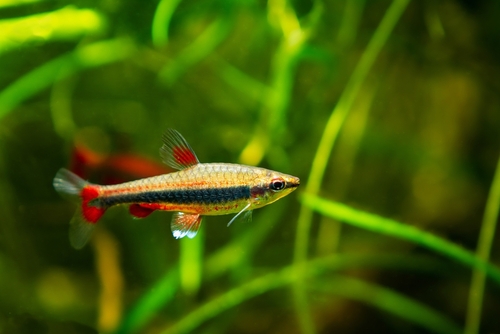
- Scientific Name: Nannostomus – (last name depends on particular species chosen)
- Adult Size: Up to about 2 inches
- Preferred Tank Mates: Apistogrammas, corydoras, neon tetras, rasboras
- Preferred Water Temperature: 75 to 80 degrees Fahrenheit
- Minimum Tank Size: 20 gallons
- Difficulty of Care: Intermediate
- Origin: South America
These little fish are adorable top-dwellers that enjoy flitting about their environment. In addition to being very peaceful and entertaining fish, they’re small and unlikely to have negative interactions with your Apistogrammas
Pros/Cons:
| Top dwelling – no territory conflict | May jump out of the tank if not properly secured |
| Small – don’t need much space | Happiest in groups of 6 or more |
| Entertaining to watch | Don’t like extreme changes – require careful watching |
6. Otocinclus Catfish
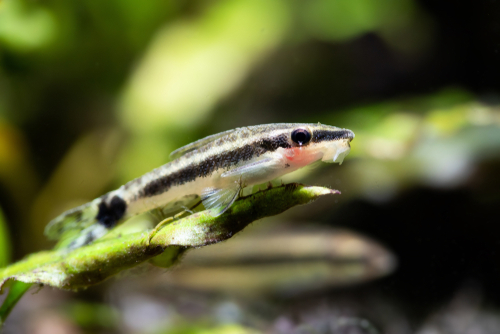
- Scientific Name: Macrotocinclus afinnis
- Adult Size: 1 to 2 inches
- Preferred Tank Mates: Apistogrammas, Tetras, Dwarf Gourami. Corydoras, Rasboras
- Preferred Water Temperature: 72 to 79 degrees Fahrenheit
- Minimum Tank Size: 10 gallons
- Difficulty of Care: Easy
- Origin: South America
These fish are small, fast, and very friendly. Even though they share territory with Apistogrammas, as long as they have hiding spaces to dart around and into, not even the crankiest fish will upset them.
Pros/Cons:
| Eat primarily algae – easy to feed | Territory overlap with Apistogrammas |
| Very docile temperaments | Remember to provide supplements to diet |
| Don’t need a lot of space |
7. Cardinal Tetra
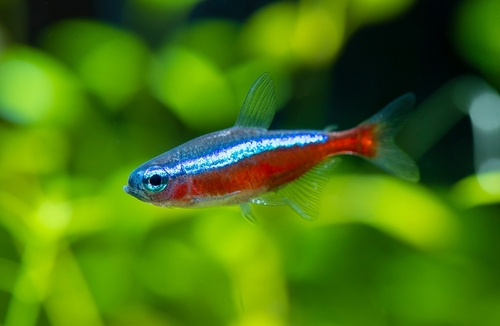
- Scientific Name: Paracheirodon axelrodi
- Adult Size: About 2 inches
- Preferred Tank Mates: Apistogrammas, Neon Tetras, Black Skirt Tetra, Dwarf Gourami
- Preferred Water Temperature: 73 to 81 degrees Fahrenheit
- Minimum Tank Size: 20 gallons
- Difficulty of Care: Beginner to Intermediate
- Origin: South America
These small and fantastically colored fish are amazing to watch. Brightly colored and active swimmers, they enjoy making space in the middle of the tank, so your Apistogrammas will have plenty of space to coexist in the bottom.
Pros/Cons:
| Beautiful and active – fun to watch | Need plenty of hiding spaces to play in |
| Easy to feed omnivores – prefer protein | Need certain foods for balanced diet |
| No territory issues with Apistogrammas | Prefer to live in schools of 6 or more |
8. Ram Cichlid
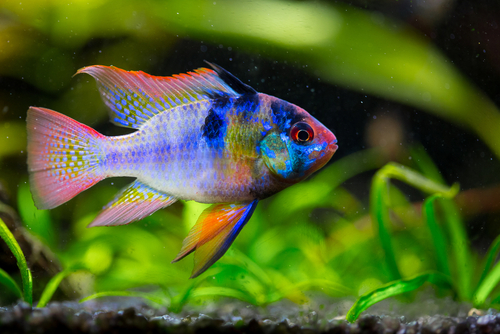
- Scientific Name: Mikrogeophagus ramirezi
- Adult Size: 2 – 3 inches
- Preferred Tank Mates: Apistogrammas, Cardinal Tetra, Angelfish, Neon Tetra, Kuhli Loach
- Preferred Water Temperature: 78 to 85 degrees Fahrenheit
- Minimum Tank Size: 20 – 30 gallons
- Difficulty of Care: Moderate
- Origin: South America – Orinoco River Basin specifically
These are another small, and extremely peaceful species of cichlid, and known for being the most amiable and compatible of cichlids to inhabit a tank with Apistogrammas. If you’re looking for an all-cichlid community, these are your best choice.
Pros/Cons:
| Very easy-going and compatible with Apistogrammas | Will get aggressive without enough hiding spots |
| Easy to feed – omnivores | Can be competition for food |
| Excellent community fish | Like warmer water than many Apistogrammas |
9. Dwarf Gourami
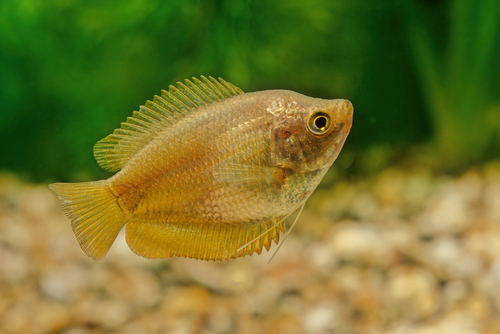
- Scientific Name: Trichogaster lalius
- Adult Size: 3 to 5 inches
- Preferred Tank Mates: Apistogrammas, Tetras, Rasboras, Loaches
- Preferred Water Temperature: 72 to 82 degrees Fahrenheit
- Minimum Tank Size: 10 – 2o gallons
- Difficulty of Care: Beginner
- Origin: India and surrounding area
With their rainbow-colored scales and peaceful natures, these fish are excellent companions for an Apistogramma. They also prefer dwelling in the middle levels of the tank, so there will be no territory disputes.
Pros/Cons:
| Easy-going and relatively friendly | Need a school of 5 or 6 to be happy |
| Small fish that don’t require much care | Need a mix of foods to be healthy |
| Eats mostly bugs and protein/vegetable matters |
10. Black Skirt Tetra
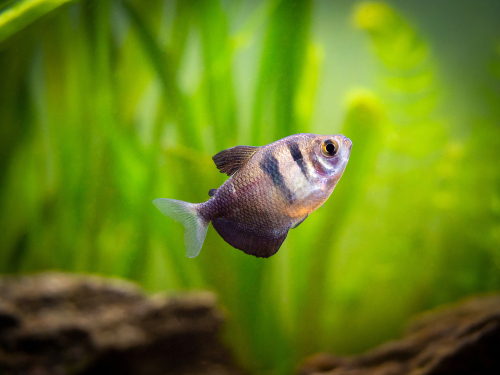
- Scientific Name: Gymnocorymbus ternetzi
- Adult Size: About 2 inches
- Preferred Tank Mates: Apistogrammas, Neon Tetras, Dwarf Gouramis, Cardinal Tetra,
- Preferred Water Temperature: 70 to 85 degrees Fahrenheit
- Minimum Tank Size: 15 to 20 gallons
- Difficulty of Care: Easy to Intermediate
- Origin: South America
These small fish prefer the middle and upper layers of the tank, and they’re fairly easy going. They’re also energetic and multi-colored, marked by their black stripes that make them distinctive.
Pros/Cons:
| Easy to feed – omnivores | May be competition for food |
| Middle dwellers – no space competition | Have been known to jump out of the tank if not properly secured |
| Friendly and energetic and fun to watch | Need at least 5 in community to be happy |
11. Dwarf Rainbowfish
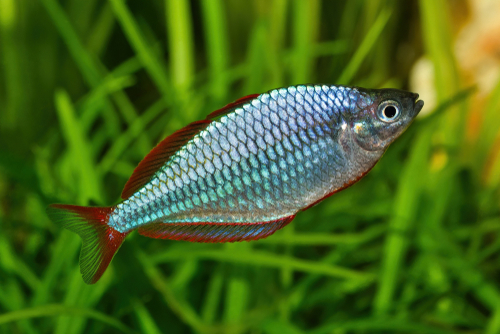
- Scientific Name: Melanotaenia praecox
- Adult Size: 2 -3 inches
- Preferred Tank Mates: Apistogrammas, Tetras, Angelfish, Corydoras
- Preferred Water Temperature: 74 to 82 degrees Fahrenheit
- Minimum Tank Size: 20 gallons
- Difficulty of Care: Moderate
- Origin: Near Indonesia
These brightly colored fish are energetic and love to swim. As middle and surface dwelling fish, they won’t compete with you Apistogrammas in terms of space, and they’re fun to watch.
Pros/Cons:
| easy to feed – omnivores with preference for protein | May be competitors for food |
| Pretty and fast moving | Need plenty of space to swim |
| Fairly social fish | Prefer to live in groups of 6 or more |
12. Kuhli Loach
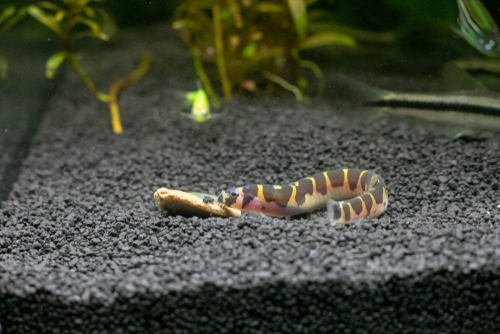
- Scientific Name: Pangio kuhlii
- Adult Size: 3 to 5 inches
- Preferred Tank Mates: Apistogrammas, Tetras, Rasboras, Danios
- Preferred Water Temperature: 73 to 86 degrees Fahrenheit
- Minimum Tank Size: 15 gallons
- Difficulty of Care: Moderate
- Origin: Around Malaysia
These are a unique looking breed of fish, also called the Leopard Loach. They’re lovely scavengers and shy, retiring fish with a resemblance to eels, and they make an interesting addition to any tank.
Pros/Cons:
| Scavengers who eat primarily protein | Tend to compete with Apistogrammas for food and area |
| Shy and non-confrontational | Nocturnal and prone to hiding |
Final Thoughts:
These are just a few fish that can serve as excellent tank mates for an Apistogramma. Whichever fish you choose is sure to provide an interesting addition to your aquarium.

Ian Sterling, founder of Fishlab.com, began his aquarium journey over 30 years ago, driven by a deep fascination for fish and their diverse personalities. His website, Fishlab.com, is dedicated to making fishkeeping accessible and enjoyable, offering beginner-friendly guidance, expert insights, and a community for aquarists to connect and share experiences.


